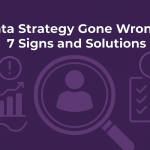- Ever feel like you’re making decisions in the dark?
- You’re drowning in reports but starving for Insights
- Your KPIs are based on gut feelings, Not data
- Your data Is a disorganized mess
- You’re reacting instead of predicting
- No one actually trusts the data
- Your strategy was set… Three CEOs ago
- You’re spending more than you’re earning on data tools
- How to turn it around: Start with DataGenie
- FAQs
Ever feel like you're making decisions in the dark?
You’ve got dashboards, reports, and analytics galore. But something’s off. Sales forecasts miss the mark, marketing campaigns flop, and customer complaints pile up.
You’re not alone. Many businesses in the UK, US, Canada, and Australia believe they have a solid data strategy. But in reality? They’re often swimming in messy, misleading, or misunderstood data — especially when key performance indicators (KPIs) are misaligned, outdated, or poorly defined.
Let’s talk about the red flags. The silent killers. The mistakes hiding in plain sight that are quietly costing your business thousands (or more).
And don’t worry—this isn’t just a callout post. We’ll also show you how to turn things around. Because that’s what DataGenie does best: making sense of your data so your decisions actually make sense.
1. You're drowning in reports but starving for Insights
More reports doesn’t equal better decisions. If your team spends more time creating dashboards than using them, you’ve got a problem.
Why it happens: Too many tools, disconnected systems, and a lack of centralized reporting often lead to redundant work. Teams end up juggling spreadsheets, toggling between apps, and interpreting numbers that don’t quite align.
What to do: Start by asking: what do we really need to know? Then streamline your data sources. Invest in a centralized BI (Business Intelligence) tool that connects to all your data repositories. Don’t measure everything—just the metrics that move the needle. Train your team to interpret results rather than just present them.
According to Forrester, between 60% to 73% of all enterprise data goes unused for analytics. That’s a lot of missed opportunity.
DataGenie Insight: Our clients reduce data prep time by 40% in the first month. That’s time they get back to actually think.
2. Your KPIs are based on gut feelings, Not data
“Let’s aim for 10% growth this quarter.” Okay, cool. Based on what?
Why it happens: Leadership may set ambitious goals without checking the data story. Maybe there’s pressure from investors or a need to match competitors. But without trend analysis, customer behavior insights, or market conditions, these numbers are just wishful thinking.
What to do: Make sure your KPIs reflect both historical performance and realistic projections. Use forecasting tools that account for seasonal trends, sales cycles, and customer churn. Turn your gut checks into data-backed validations. Set thresholds, monitor deviations, and adjust course proactively.
McKinsey reports that data-driven organizations are 23 times more likely to acquire customers and 6 times as likely to retain them.
3. Your data Is a disorganized mess
If your data were a wardrobe, would it be Marie Kondo… or a teenage tornado?
Why it happens: When teams store data in different formats, across different platforms, and name files inconsistently, things get messy—fast. And let’s not even talk about version control issues or that mystery Excel file named “Final_FINAL_v9”.
What to do: Implement a robust data governance policy. Use a lead database management tool that automates cataloging, validation, and deduplication across your tech stack. Standardize naming conventions. Build a culture of documentation. And when in doubt, audit your data warehouse to clean out the junk.
Gartner estimates that poor data quality costs organizations an average of $12.9 million per year.
4. You’re reacting instead of predicting
If your team only looks at data after something goes wrong, you’re playing defense.
Why it happens: Many businesses rely solely on historical data. Without proactive monitoring or predictive modeling, decisions are made in hindsight. And by the time you realize something broke, it’s already cost you money or customers — and it’s a sign that data-driven decision making isn’t fully in place.
What to do: Integrate real-time analytics dashboards. Set anomaly detection alerts. Use machine learning models to forecast customer churn, product demand, or operational risk. Don’t wait for red flags to pop up—create systems that warn you before they do. That’s the foundation of true data-driven decision making.
A recent PwC study found that companies using predictive analytics are 5 times more likely to make faster decisions.
5. No one actually trusts the data
Ever heard someone say, “I don’t trust these numbers”? That’s not just a red flag. That’s a billboard.
Why it happens: Inconsistent data quality, errors in reporting, and lack of transparency lead to distrust. When employees see different results depending on where they look, it’s no surprise they stop believing any of it.
What to do: Build confidence through data lineage (show where the data came from). Maintain audit trails and regular health checks. Train staff to understand how the data is sourced and calculated. Build dashboards that not only show numbers but show their credibility.
Experian’s Data Quality Report shows that 95% of businesses see impacts in operational efficiency due to poor data quality.
DataGenie Tip: We build in trust indicators, so your team knows they’re seeing clean, current, and complete data.
6. Your strategy was set... Three CEOs ago
Data strategies aren’t tattoos. You don’t set them once and forget them.
Why it happens: New leadership often focuses on immediate KPIs rather than reviewing old infrastructure. As a result, outdated tools, workflows, and assumptions live on far past their expiration date.
What to do: Build in strategy reviews. Just like you review budgets quarterly goals, your data roadmap deserves regular attention. Ask yourself: Are we using the best data strategy tools for B2B growth, or are we stuck with outdated systems that no longer align with today’s goals. Are the questions we’re asking still aligned with the market? Adaptability is key to staying competitive.
IDC research reveals that organizations that update their data strategies annually see 2.5x improvement in ROI from analytics investments.
7. You're spending more than you're earning on data tools
SaaS sprawl is real. If your tech stack looks like a periodic table, that’s a problem.
Why it happens: Teams buy tools to solve isolated problems — often overlooking whether existing platforms can already handle those needs. Over time, subscriptions multiply. Some tools go unused, others overlap, and costs spiral. Especially in areas like data visualization, where multiple tools often perform similar functions.
What to do: Conduct a full audit of your stack at least once a year. Track usage, ROI, and training costs. Focus on platforms that integrate well and deliver multi-function value — especially when it comes to data visualization, reporting, and analytics. Sometimes, the best upgrade isn’t new software — it’s better adoption of what you already own.
According to Zylo, companies underestimate SaaS spend by over 40%, often due to unused or redundant tools.
How to turn it around: Start with DataGenie
At DataGenie, we don’t just wrangle your data. We build a strategy that scales with you. We work with companies across the UK, US, Canada, and Australia to clean, organize, visualize, and most importantly—make data useful.
- Custom dashboards built around your KPIs
- Clean data pipelines, minus the stress
- Predictive models that actually predict things
Let’s get your data working for you, not against you.
FAQs
Q: How do I know if my data strategy is outdated?
A: If you haven’t reviewed your strategy in over a year, it’s time. New tools, trends, and customer expectations evolve constantly.
Q: Can DataGenie help with cleaning existing data?
A: Absolutely. Cleaning and structuring messy data is our jam.
Q: We’re a small business. Is this still relevant to us?
A: 100%. Bad data decisions hurt small teams even more. Let us help you avoid the landmines.
Q: How long does it take to see results?
A: Many clients notice streamlined operations and clearer decision-making within the first 30 days.

Elizabeth Jones, Data expert at DataGenie, helps businesses turn data into clear, practical insights. She's great at simplifying complex ideas, making data useful and easy to understand. Elizabeth regularly shares tips on professional networks and actively joins discussions on X (formerly Twitter). Follow her posts on the DataGenie blog for straightforward advice on making data work better for your business.




